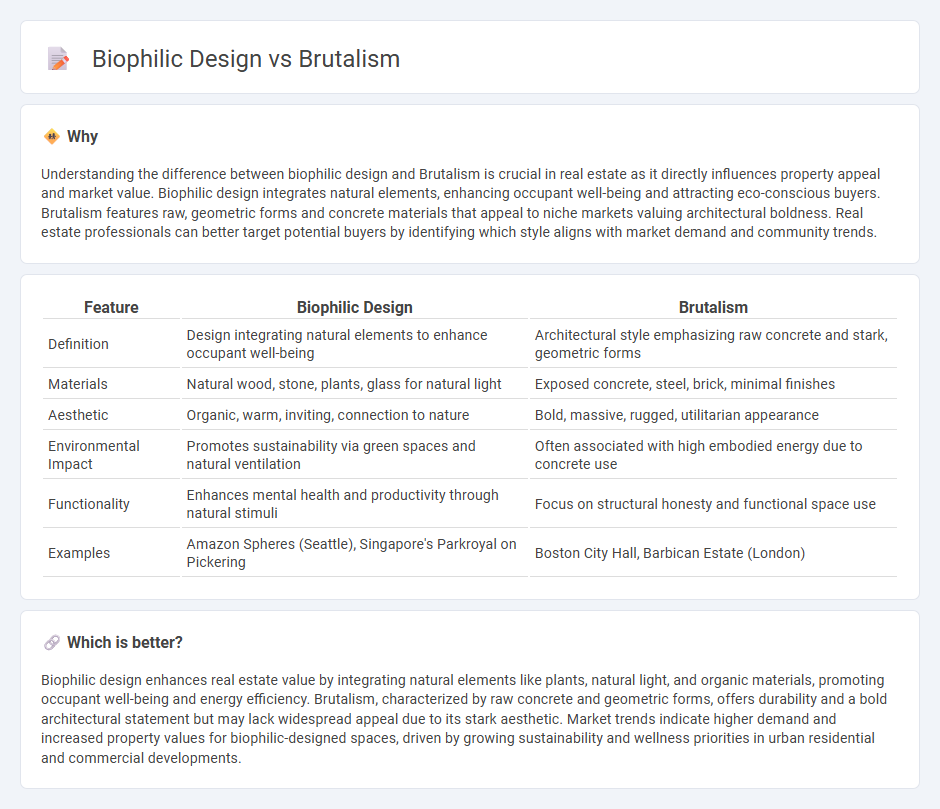
Biophilic design emphasizes natural elements, organic shapes, and sustainable materials to create harmonious living spaces that enhance well-being and connection to nature. In contrast, Brutalism features raw concrete, bold geometric forms, and an industrial aesthetic that highlights structural functionality over comfort. Discover how these contrasting architectural styles influence property value and resident experience.
Why it is important
Understanding the difference between biophilic design and Brutalism is crucial in real estate as it directly influences property appeal and market value. Biophilic design integrates natural elements, enhancing occupant well-being and attracting eco-conscious buyers. Brutalism features raw, geometric forms and concrete materials that appeal to niche markets valuing architectural boldness. Real estate professionals can better target potential buyers by identifying which style aligns with market demand and community trends.
Comparison Table
| Feature | Biophilic Design | Brutalism |
|---|---|---|
| Definition | Design integrating natural elements to enhance occupant well-being | Architectural style emphasizing raw concrete and stark, geometric forms |
| Materials | Natural wood, stone, plants, glass for natural light | Exposed concrete, steel, brick, minimal finishes |
| Aesthetic | Organic, warm, inviting, connection to nature | Bold, massive, rugged, utilitarian appearance |
| Environmental Impact | Promotes sustainability via green spaces and natural ventilation | Often associated with high embodied energy due to concrete use |
| Functionality | Enhances mental health and productivity through natural stimuli | Focus on structural honesty and functional space use |
| Examples | Amazon Spheres (Seattle), Singapore's Parkroyal on Pickering | Boston City Hall, Barbican Estate (London) |
Which is better?
Biophilic design enhances real estate value by integrating natural elements like plants, natural light, and organic materials, promoting occupant well-being and energy efficiency. Brutalism, characterized by raw concrete and geometric forms, offers durability and a bold architectural statement but may lack widespread appeal due to its stark aesthetic. Market trends indicate higher demand and increased property values for biophilic-designed spaces, driven by growing sustainability and wellness priorities in urban residential and commercial developments.
Connection
Biophilic design incorporates natural elements like plants and sunlight to enhance wellbeing, while Brutalism emphasizes raw, exposed materials and structural honesty in architecture. Both styles share a focus on authenticity and functionality, often using concrete as a dominant material that connects buildings to their environment. Integrating biophilic principles in Brutalist structures can soften the starkness, creating spaces that promote health and human connection amidst urban landscapes.
Key Terms
Materiality
Brutalism emphasizes raw concrete, steel, and exposed structural elements, showcasing the material's inherent textures and industrial aesthetic. Biophilic design incorporates natural materials such as wood, stone, and greenery to create a tactile connection to nature that enhances well-being and comfort. Explore how these contrasting material choices influence architectural experience and environmental psychology.
Natural Integration
Brutalism emphasizes raw concrete and geometric forms, often creating stark, imposing structures with minimal interaction with natural elements. Biophilic design prioritizes the integration of nature through natural light, greenery, and organic materials to enhance occupant well-being and environmental harmony. Discover how these contrasting architectural styles influence space utilization and human experience.
Aesthetic Philosophy
Brutalism emphasizes raw, unadorned materials like exposed concrete and geometric forms, reflecting a philosophy of honesty and functionality in architectural aesthetics. Biophilic design prioritizes natural elements, organic shapes, and greenery, fostering a connection between humans and nature to enhance well-being. Explore the deeper philosophical contrasts between Brutalism's stark minimalism and biophilic design's nature-inspired harmony.
Source and External Links
Brutalism | Architecture, Definition, History, & Facts - This webpage provides an overview of Brutalism as an architectural style characterized by raw concrete and utilitarian aesthetics, emerging in the mid-20th century.
Brutalist architecture - This Wikipedia page describes Brutalist architecture as a style that emerged in the 1950s, known for its use of raw concrete and emphasis on functionalism.
Brutalism - This Tate webpage explains Brutalism as an architectural style from the 1950s and 1960s, characterized by raw concrete and simple forms.
 dowidth.com
dowidth.com